

An Evaluation Study of Select Mangave Cultivars
An Evaluation Study of Select Mangave Cultivars | Issue 49 2024
Jack E. Nicholson1 and Gavin Young2
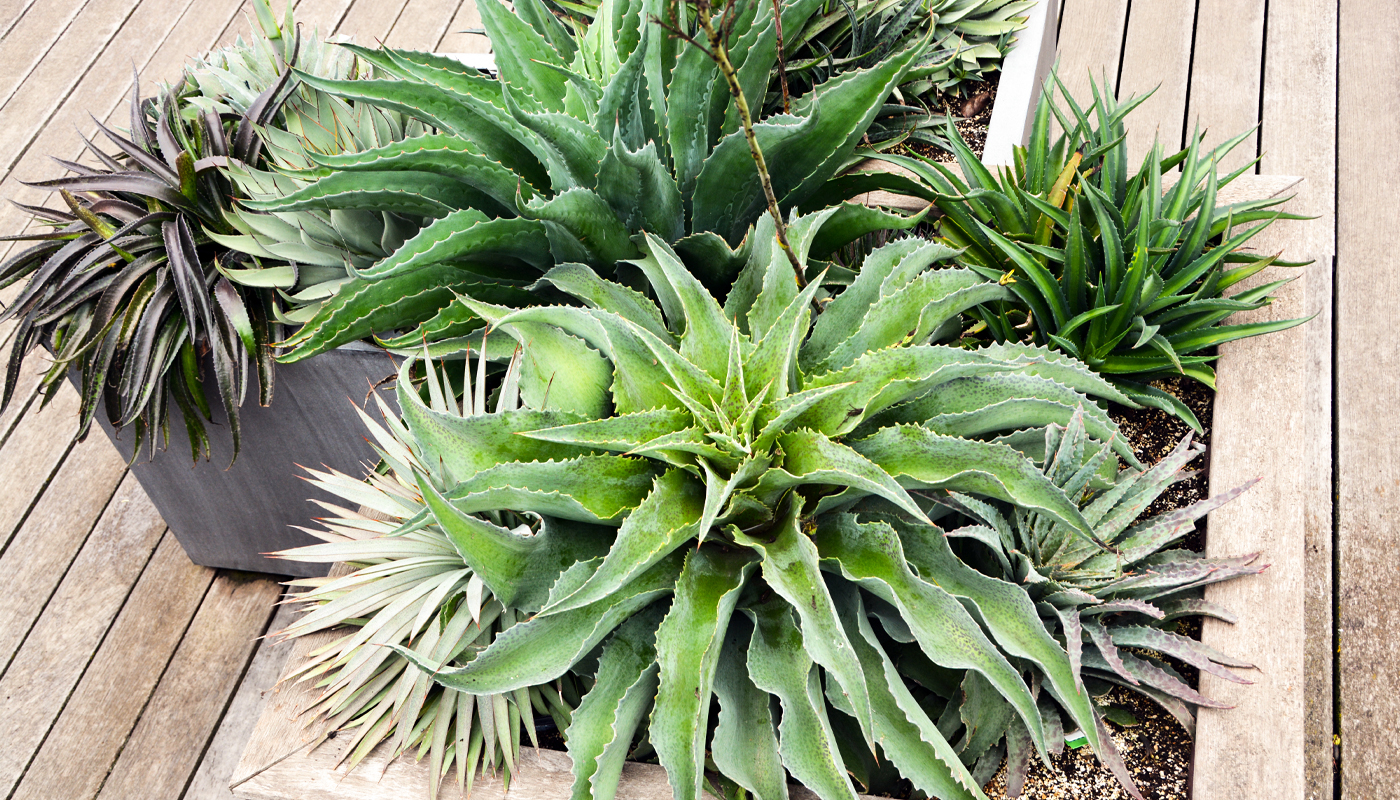
Mangaves in Chicago Botanic Garden trial planters
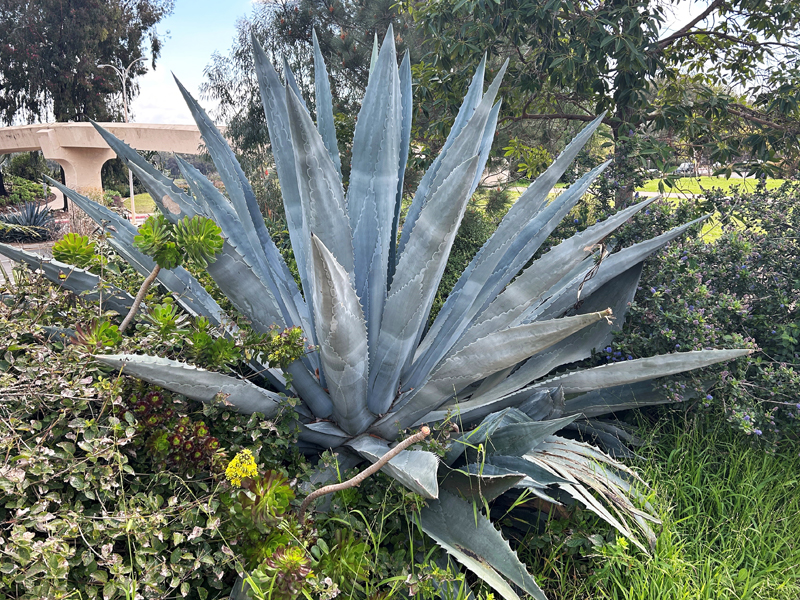
Agave americana (Photographed at Balboa Park, San Diego, California by Jack Nicholson)

Agave victoriae-reginae (Photographed at Mitchell Park Domes, Milwaukee, Wisconsin by Jack Nicholson)
![Spotted form of Manfreda virginica [Agave virginica] (Photographed by Sid Vogelpohl)](/sites/default/files/inline-images/3.jpg)
Spotted form of Manfreda virginica [Agave virginica] (Photographed by Sid Vogelpohl)

Inflorescence of ‘Painted Desert’
If ×Mangave sounds unfamiliar, it is probably because these plants are relatively new on the horticultural scene. This name is a portmanteau for the intergeneric cross between Manfreda and Agave, two closely related succulent plant groups in the asparagus family (Asparagaceae). Genetic analysis shows that species formerly classified as Manfreda—and by extension ×Mangave—properly belong nestled within the Agave genus. We acknowledge the nothogenus name ×Mangave here because the original nomenclature is commonly used in the nursery industry. However, throughout the remainder of this report, ×Mangave is reduced to the status of a common name—mangave. Regardless of taxonomy, the mangave phenomenon warrants its own recognition. First coined in the early 2000s, the selection of mangaves on the market exploded in the past decade thanks largely to the work of Hans Hansen at Walters Gardens, Zeeland, Michigan. Combining the unique characteristics in Manfreda and Agave, Hansen and others have produced a menagerie of hybrids featuring novel combinations of colors, patterns, and forms. Spotted, striped, or solid; spiny or smooth; stiff or soft; and everything in between, these collectible curiosities are sure to appeal to any gardener looking for a showpiece plant.
Agave is a widely cultivated genus of more than 200 species native to predominantly hot, dry regions of the southwestern United States, Mexico, Central America, and the Caribbean. Agaves are famously monocarpic, meaning they only flower and set seed once before dying, although the mother plant is often succeeded by offsets called pups. The common name “century plant” refers to the fact that it takes several years—often decades—for an agave to bloom. Their rigid, evergreen, succulent leaves are armed with a vicious terminal spine and often feature teeth on the margins as well. Agaves come in a variety of colors, sizes, and forms, ranging from the imposing American century plant (Agave americana) to the compact and elegant Queen Victoria agave (A. victoriae-reginae). These plants are prized in gardens around the world for their sculptural forms and drought tolerance.
Manfreda, a lesser-known group native to the southeastern United States, Texas, and northern Mexico, are variously known as false aloes, tuberoses, or spice lilies. Despite their reclassification within Agave, species formerly assigned to Manfreda have numerous characteristics that set them apart from the rest of the genus. With a preference for higher moisture levels and soft, deciduous foliage with only innocuous serrations, Manfreda species behave more like typical herbaceous perennials than their spiky, desert-dwelling cousins. Furthermore, their bloom cycle is more like a hosta than a typical agave: individual rosettes bloom each year, but new ones are continually generated from an underground corm. Notably, some possess red or purple spots on their leaves—a trait highlighted in many mangave cultivars.
Mangaves are low-maintenance and versatile additions to the garden. Most are hardy to about 25 degrees Fahrenheit (USDA Hardiness Zone 9b) but some cultivars have been found to withstand temperatures below 10°F (Zone 7b). Gardeners in cooler climates can still enjoy mangaves in containers and overwinter them indoors near a sunny window. Although mangaves are drought tolerant, they thrive and put on the most growth with a moderate amount of water; their growth rate is also much faster than most agaves. Ample UV light exposure is needed to bring out the red and purple pigmentation of many varieties to full effect; a plant grown in full sun will display much richer colors than one grown in shade. Their thick, often spiny foliage is avoided by deer and rabbits, but snails and slugs may pose an issue. In areas where agaves are commonly grown, mangaves can be affected by the agave snout weevil, an insect whose larvae burrow and feed on the core of the plant, which is fatal unless caught very early. This pest can be prevented or treated with systemic insecticides containing imidacloprid. Mangaves are monocarpic like their agave parents but bloom much faster—some in as little as one or two years. Tubular green, yellow, or pinkish flowers are borne on an inflorescence towering several feet above the rest of the plant. The main rosette will die after flowering, but most varieties produce basal pups or bulbils which can be easily moved around the garden or shared with others.
The architectural forms, varied textures, and striking colors and patterns of mangaves make them ideal focal points in landscapes and containers. Grouping a collection of different mangaves together, as seen in our trial, highlights the unique attributes of each variety. With their adaptability to a range of watering schedules, mangaves are suited for combinations with other succulents as well as many annuals and perennials, provided the soil is well-drained.
List of Sections
Hans Hansen on Breeding Mangaves
Trial Details
Observations
Ratings
Conclusion
References and Citations
Avent, Tony. “Mesmerizing Mangaves - A Star Is Born.” Plant Delights Nursery, 24 May 2022.
Baldwin, Debra Lee. “Agave Snout Weevil Prevention and Treatment.” Debra Lee Baldwin.
Vogelpohl, Sid. “Know Your Natives – False Aloe.” ANPS.org.
1Jack E. Nicholson, plant evaluation assistant 2023 – 24.
2Gavin Young, plant evaluation assistant 2021 – 22.
3Measurements taken September 2021, averaged between two plants.
Photographs by Gavin Young unless otherwise noted
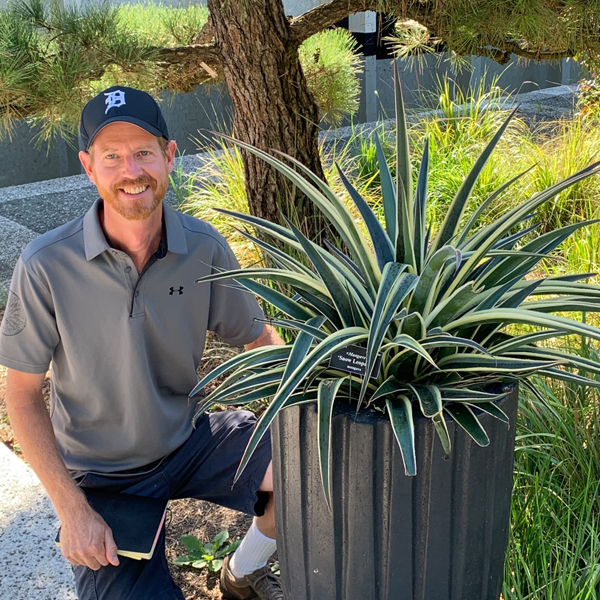
Hans Hansen on Breeding Mangaves
“It’s hard for me to believe it’s been more than 20 years since the first time I heard the word mangave.”
While managing a tissue culture lab at Shady Oaks Nursery in Waseca, Minnesota, in 2003, I received a call from Tony Avent of Plant Delights Nursery in Raleigh, North Carolina. Tony had leads on a monster plant—an intergeneric cross between a Manfreda and an Agave. He asked if I would be willing to put it into tissue culture and produce it for him. Tony had a colleague— Carl Schoenfeld at Yucca Do Nursery in Texas—who had botanized in Mexico in the late 1990s and collected seeds of Manfreda variegata [Agave variegata]. After germinating the seeds, two of the seedlings in the flat did not resemble the rest. Tony traveled to the nursery in Texas to see the plants firsthand, and it was then that Tony and Carl realized this must be a serendipitous cross between the Manfreda and an Agave. Carl remembered Agave celsii [A. mitis] also grew at the site where the original seeds of the Manfreda were collected. That jaw-dropping moment was the first known intergeneric hybrid between these two genera.
In 2004, the first plants of the more distinctive clone from this original cross were offered to the horticultural world jointly by Yucca Do Nursery and Plant Delights Nursery under the name ×Mangave ‘Macho Mocha’. The plant is intermediate between the two parents, with mahogany red leaves. During the tissue culture process, I developed and stabilized both marginal- and medio-variegated sports of ‘Macho Mocha’. The creamy white sport was named ‘Espresso’ and released by Plant Delights Nursery in 2009; I named the white-centered form ‘Cappuccino’, and it was first offered by Plant Delights Nursery in 2015.
After having the privilege of propagating this cool plant, I began making my own bigeneric hybrids. I did not have much germplasm in Minnesota, other than a wild-collected form of Manfreda virginica [Agave virginica], which was an extremely red-spotted form I received from the late Bob Stewart at Arrowhead Alpines in Fowlerville, Michigan. During this time, Tony acquired another mangave—an incredible eBay score from Japan called ‘Bloodspot’. This mangave was an intentional hybrid between Manfreda maculosa [Agave maculata] and Agave macroacantha. Unlike the large architectural form of ‘Macho Mocha’, ‘Bloodspot’ was a small, cute plant with a multitude of heavily red-spotted narrow leaves.
In 2009, I moved to Michigan and began my career as a fulltime plant hybridizer at Walters Gardens. Among the 70 plus genera of plants I was working on was mangave. I began assembling a collection of Manfreda and, of course, the two known mangave hybrids. I began hybridizing them and through the generosity of Tony Avent, the JC Raulston Arboretum, and folks with private gardens, I amassed a substantial Agave pollen bank to work with.
In 2016, Walters Gardens introduced the first of my mangave hybrids, ‘Pineapple Express’, a selection of the 2011 cross between ×Mangave ‘Jaguar’ and ×Mangave ‘Bloodspot’. This rapidly growing hybrid produces an upright, pineapple-like crown of dark green leaves heavily dotted with burgundy spots.
Since the introduction of ‘Pineapple Express’ I have selected and named 82 mangave varieties. Thirty-five are currently marketed through the Mad About Mangave® program. Highlights include ‘Lavender Lady’, ‘Red Wing’, ‘Mission to Mars’, and ‘Racing Stripes’.
Mangaves resonate with a younger crowd. Although mangaves are embraced and collected by the succulent groups, millennials have taken them to another level through social media. As one collector put it: ‘They are so Instagrammable!’
The mangave project has been the most rewarding breeding project I have been involved in; unlike hostas or daylilies, the field was not crowded when I began making crosses, and many of the plants in the early work are standing the test of time and will provide the building blocks for future generations of hybridizers and gardeners.”
-
Thirty-seven mangave cultivars—all Walters Gardens introductions— were evaluated over the course of two years (2020 – 21). During the growing season, the trials were conducted in planters located on the green roof of the Daniel F. and Ada L. Rice Plant Conservation Science Center at the Chicago Botanic Garden (USDA Hardiness Zone 6a, AHS Plant Heat Zone 5) and relocated to overwinter in production greenhouses from October to May. Additional data on flowering age was collected for about half of the taxa in December 2023 as they were kept in the greenhouses as part of the Chicago Botanic Garden’s permanent collection.
During the growing season, the mangaves were sunken in their individual nursery containers into the larger planters. One individual of each variety was placed on the north and south portions of the green roof with both locations receiving full sun exposure. In the first year, the mangaves were potted in a medium composed of standard perennial potting mix, sand, and lava rock in a 1:1:2 ratio. The second year, they were repotted in a mix consisting of the same components in a 1:1:1 ratio. Annuals were grown in between the mangaves in the first season of the trial, but by the second season the trial subjects had grown so large there was no space for additional plants. Maintenance practices were kept to a minimum, which consisted of weeding and watering when necessary, allowing the plants to fail or thrive under normal growing conditions.
Being all-around tough plants, typical evaluation criteria such as vigor, disease resistance, and overall hardiness were less relevant to final ratings in this trial compared to other perennial and shrub trials. Cultivars are instead ranked mainly on their overall visual impression and combination of Manfreda and Agave traits that create a novel and intriguing plant. The highest-rated selections were those that particularly stood out to the evaluators; the good-rated plants were attractive, interesting, and performed well; the fair-rated plants had a generally attractive presentation but were lackluster compared to other varieties; while the bottom-ranked selections performed poorly and/ or had an unappealing presentation within the trial.
Thirty-seven mangave cultivars—all Walters Gardens introductions— were evaluated over the course of two years (2020 – 21). During the growing season, the trials were conducted in planters located on the green roof of the Daniel F. and Ada L. Rice Plant Conservation Science Center at the Chicago Botanic Garden (USDA Hardiness Zone 6a, AHS Plant Heat Zone 5) and relocated to overwinter in production greenhouses from October to May. Additional data on flowering age was collected for about half of the taxa in December 2023 as they were kept in the greenhouses as part of the Chicago Botanic Garden’s permanent collection.
During the growing season, the mangaves were sunken in their individual nursery containers into the larger planters. One individual of each variety was placed on the north and south portions of the green roof with both locations receiving full sun exposure. In the first year, the mangaves were potted in a medium composed of standard perennial potting mix, sand, and lava rock in a 1:1:2 ratio. The second year, they were repotted in a mix consisting of the same components in a 1:1:1 ratio. Annuals were grown in between the mangaves in the first season of the trial, but by the second season the trial subjects had grown so large there was no space for additional plants. Maintenance practices were kept to a minimum, which consisted of weeding and watering when necessary, allowing the plants to fail or thrive under normal growing conditions.
Being all-around tough plants, typical evaluation criteria such as vigor, disease resistance, and overall hardiness were less relevant to final ratings in this trial compared to other perennial and shrub trials. Cultivars are instead ranked mainly on their overall visual impression and combination of Manfreda and Agave traits that create a novel and intriguing plant. The highest-rated selections were those that particularly stood out to the evaluators; the good-rated plants were attractive, interesting, and performed well; the fair-rated plants had a generally attractive presentation but were lackluster compared to other varieties; while the bottom-ranked selections performed poorly and/ or had an unappealing presentation within the trial.
-
Many of the cultivars exhibited more intense coloration in the first year of the trial than the second. Any spotting was darker, and the foliage had stronger red, purple, or bronze tones overall, fading to more green and blue tones in the second year. ‘Frosted Elegance’ displayed pinkish leaf margins that were completely absent the second season. This may have resulted from the plants being exposed to full outdoor sun exposure for the first time or because the planting mix had less fertility and water-holding capacity the first year. It would be worthwhile to observe how specific abiotic stresses such as drought, heat, cold, and lack of soil fertility might impact mangave coloration as they do in other succulents.
With foliage color, patterning, and form being mangaves’ main draw, blooming was generally detrimental to their aesthetic value. While the towering flower stalks added drama and attracted hummingbirds, the monocarpic nature of mangaves meant blooming greatly affected the plant’s habit. In preparation to bloom, foliage would elongate and lose intensity in its coloration and patterning. An attractive rosette was replaced by an ugly stump as the plant slowly withered away. Variations in flowering behavior greatly affected the long-term ornamental quality of each cultivar. Some bloomed within the first year after planting, and others have yet to bloom after four years. Some pupped so prolifically that the death of the parent plant was hardly noticeable, while some produced few to no pups so blooming disfigured or killed the plant altogether. In some varieties, like ‘Silver Fox’ and ‘Catch a Wave’, pups flowered simultaneously, creating a striking display, but preventing the opportunity to propagate for future enjoyment. ‘Man of Steel’ was unique in producing side shoots within the main rosette after flowering, a trait shared with Agave striata, one of its parents. Ideally, a longer trial would indicate every cultivar’s timeframe and capacity to recover after flowering. A trend was observed wherein cultivars with a more Manfreda-like phenotype—soft, strappy leaves and prolific pupping—tended to bloom the fastest. This likely reflects a greater proportion of Manfreda parentage as Manfreda flower much faster than typical Agave species.
Pest and disease issues were minimal, with the exception being a scale outbreak likely contracted during the plants’ first stint in the greenhouse. This affected only four cultivars and was first noted because of the swarms of wasps feeding on the honeydew produced by the scale. Fortunately, the outbreak subsided over the growing season and the plants were not left with any noticeable damage.

‘Frosted Elegance’ in 2020
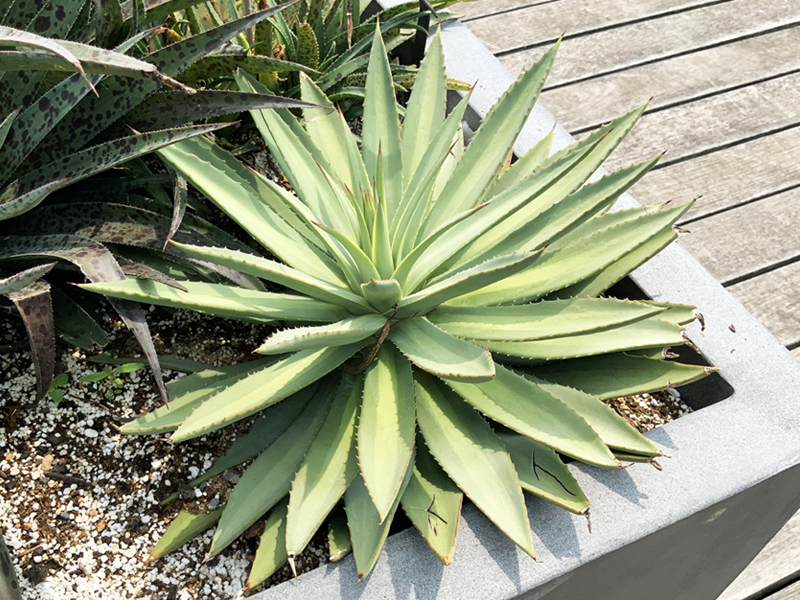
'Frosted Elegance’ in 2021
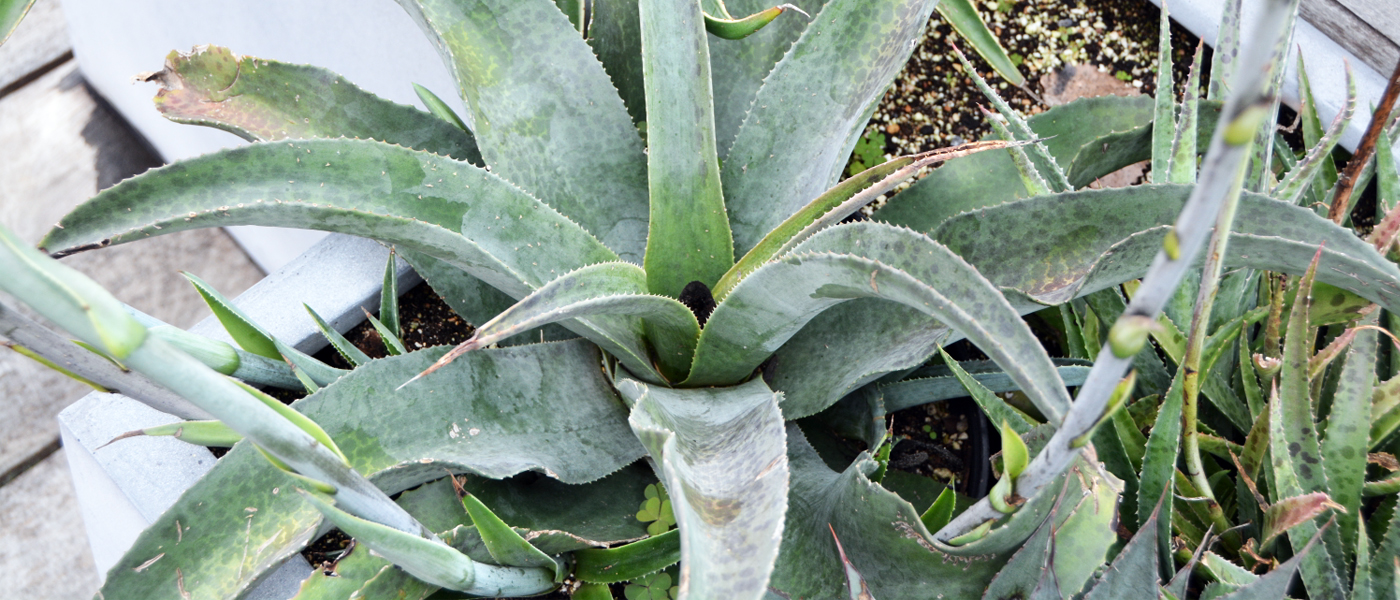
‘Catch a Wave’ with spent flower stalk in its main rosette and blooming pups
Many of the cultivars exhibited more intense coloration in the first year of the trial than the second. Any spotting was darker, and the foliage had stronger red, purple, or bronze tones overall, fading to more green and blue tones in the second year. ‘Frosted Elegance’ displayed pinkish leaf margins that were completely absent the second season. This may have resulted from the plants being exposed to full outdoor sun exposure for the first time or because the planting mix had less fertility and water-holding capacity the first year. It would be worthwhile to observe how specific abiotic stresses such as drought, heat, cold, and lack of soil fertility might impact mangave coloration as they do in other succulents.
With foliage color, patterning, and form being mangaves’ main draw, blooming was generally detrimental to their aesthetic value. While the towering flower stalks added drama and attracted hummingbirds, the monocarpic nature of mangaves meant blooming greatly affected the plant’s habit. In preparation to bloom, foliage would elongate and lose intensity in its coloration and patterning. An attractive rosette was replaced by an ugly stump as the plant slowly withered away. Variations in flowering behavior greatly affected the long-term ornamental quality of each cultivar. Some bloomed within the first year after planting, and others have yet to bloom after four years. Some pupped so prolifically that the death of the parent plant was hardly noticeable, while some produced few to no pups so blooming disfigured or killed the plant altogether. In some varieties, like ‘Silver Fox’ and ‘Catch a Wave’, pups flowered simultaneously, creating a striking display, but preventing the opportunity to propagate for future enjoyment. ‘Man of Steel’ was unique in producing side shoots within the main rosette after flowering, a trait shared with Agave striata, one of its parents. Ideally, a longer trial would indicate every cultivar’s timeframe and capacity to recover after flowering. A trend was observed wherein cultivars with a more Manfreda-like phenotype—soft, strappy leaves and prolific pupping—tended to bloom the fastest. This likely reflects a greater proportion of Manfreda parentage as Manfreda flower much faster than typical Agave species.
Pest and disease issues were minimal, with the exception being a scale outbreak likely contracted during the plants’ first stint in the greenhouse. This affected only four cultivars and was first noted because of the swarms of wasps feeding on the honeydew produced by the scale. Fortunately, the outbreak subsided over the growing season and the plants were not left with any noticeable damage.

‘Frosted Elegance’ in 2020

'Frosted Elegance’ in 2021

‘Catch a Wave’ with spent flower stalk in its main rosette and blooming pups
-

‘Aztec King’ ★★★★
Wide leaves, aqua heavily mottled with purple, arch outward in a trumpet shape. ‘Aztec King’ commands a regal presence with its bold size, form, and coloration. Unknown flowering age (at least two years). 30 in. tall × 22 in. wide3. Available in Walters Gardens 2023-2024 catalog.

‘Desert Dragon’ ★★★★
The mint green, purple-spotted leaves of ‘Desert Dragon’ fold and twist like the spiny tentacles of an undersea creature. Foliage grows outward to form a flattened mound. Unknown flowering age (at least two years). 10 in. tall × 24 in. wide. Not available in Walters Gardens 2023-2024 catalog.

‘Dreadlocks’ ★★★★
The heavily undulate margins of ‘Dreadlocks’ create a striking texture. Dark green leaves are generously spotted with purple, particularly along their centers. Pliable foliage grows out low and broad, arching down over the side when planted in a container, as in our trial. Unknown flowering age (at least two years). 10 in. tall × 30 in. wide. Available in Walters Gardens 2023-2024 catalog.
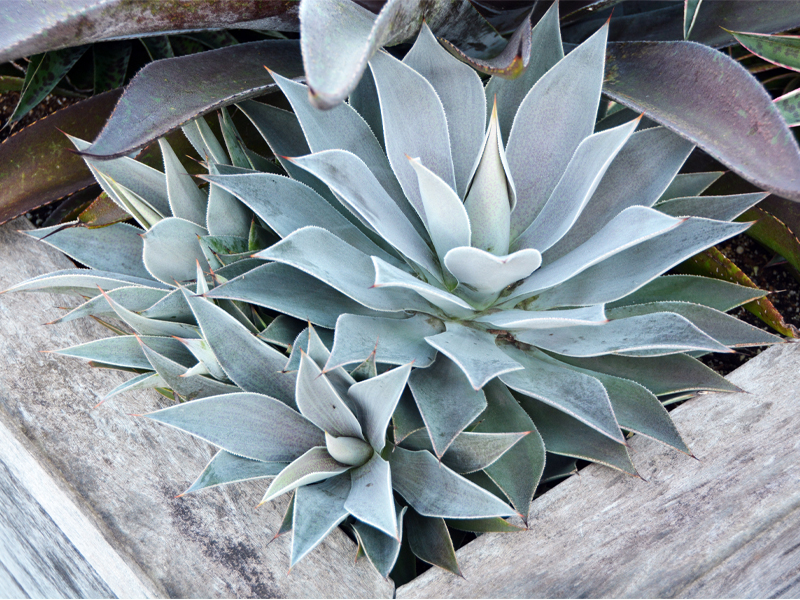
‘Lavender Lady’ ★★★★
‘Lavender Lady’ is elegant and sophisticated with its lotus-like floral form and pastel color palette. Foliage appears a solid dusty lavender but upon closer inspection is subtly spotted. Each leaf is tipped with an orange terminal spine and the white marginal serrations create a luminous glow. Unknown flowering age (at least four years). 12 in. tall × 16 in. wide. Available in Walters Gardens 2023-2024 catalog.

‘Purple People Eater’ ★★★★
Rigid leaves emerge pastel violet and gently arch and undulate outward, the lower leaves turning greener as they are shaded out. Prominent toothy margins start out yellow, aging to a cinnamon brown and finally a dark burgundy. Flowered after three to four years. 13 in. tall × 23 in. wide. Available in Walters Gardens 2023-2024 catalog.
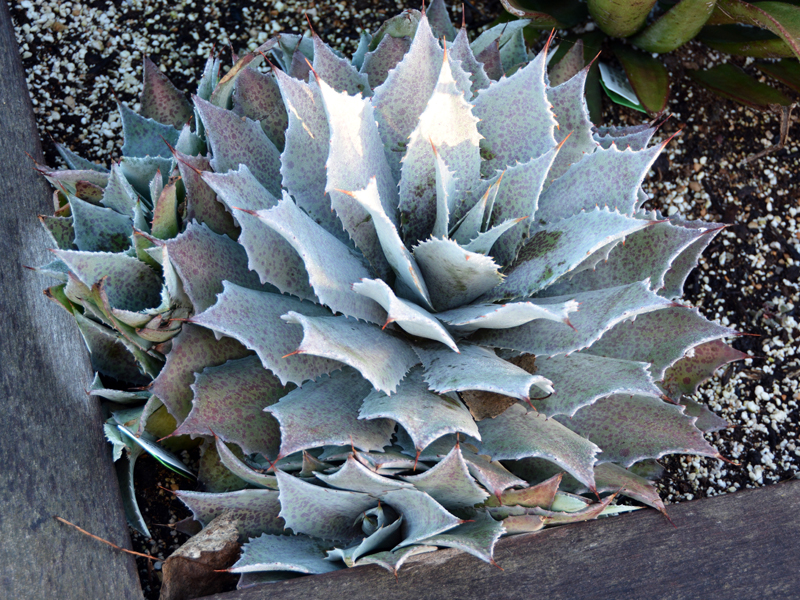
‘Sponge Paint’ ★★★★
Wide, toothed leaves form a compact rosette reminiscent of an artichoke. Foliage emerges silvery blue-green speckled with purple and tipped with an orange terminal spine. Outer leaves take on a more reddish cast as the glaucous coating fades. Flowered after two to three years. 9 in. tall × 14 in. wide. Available in Walters Gardens 2023-2024 catalog.
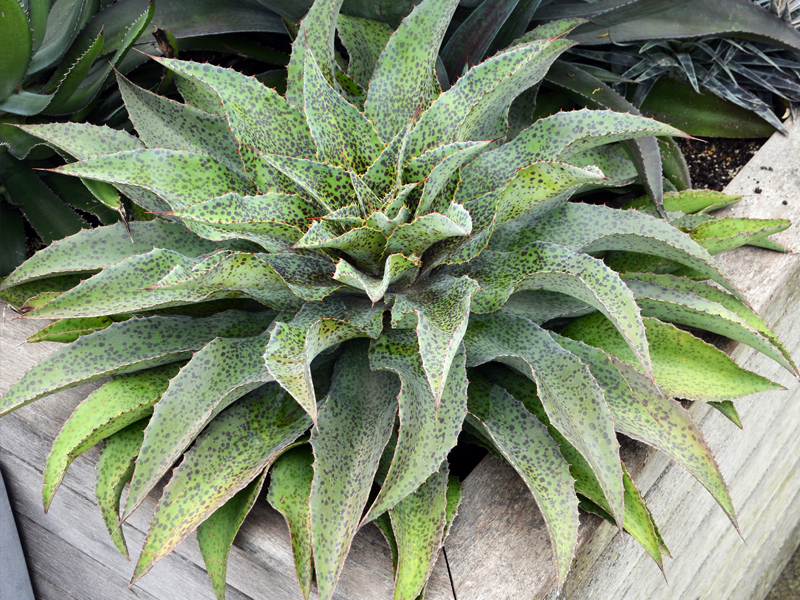
‘Spotty Dotty’ ★★★★
Dark freckles pop against jade green (golden caramel when stressed) foliage edged with rusty orange marginal spines. Broad, stiff leaves undulate and fold around one another in a strongly architectural manner. Unknown flowering age (at least four years). 15 in. tall × 30 in. wide. Available in Walters Gardens 2023-2024 catalog.
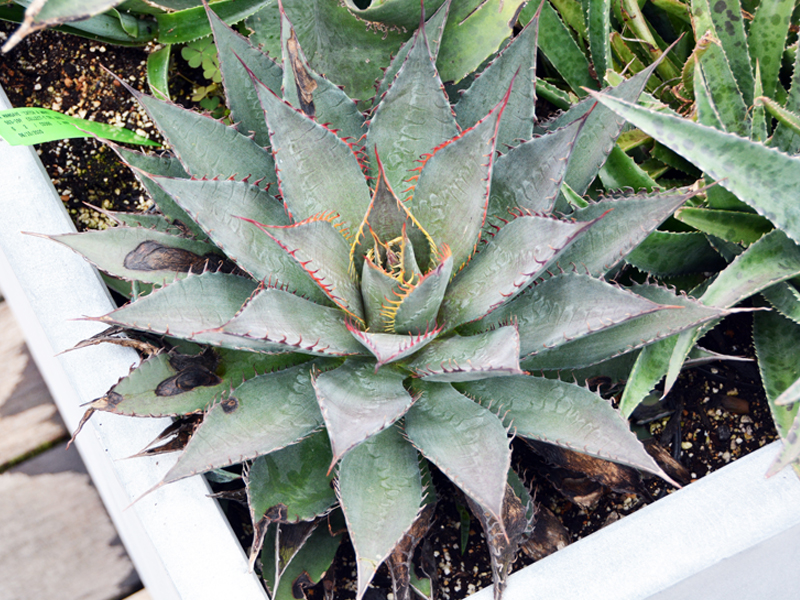
‘Tooth Fairy’ ★★★★
Wicked teeth steal the show; emerging golden yellow, they turn rusty orange and finally a deep burgundy, casting imprints as the eaves grip around one another in the central spear. The foliage is dark grayish purple with subtle spotting, tipped with a prominent terminal spine. Unknown flowering age (at least four years). 10 in. tall × 15 in. wide. Not available in Walters Gardens 2023-2024 catalog.

‘Aztec King’ ★★★★
Wide leaves, aqua heavily mottled with purple, arch outward in a trumpet shape. ‘Aztec King’ commands a regal presence with its bold size, form, and coloration. Unknown flowering age (at least two years). 30 in. tall × 22 in. wide3. Available in Walters Gardens 2023-2024 catalog.

‘Desert Dragon’ ★★★★
The mint green, purple-spotted leaves of ‘Desert Dragon’ fold and twist like the spiny tentacles of an undersea creature. Foliage grows outward to form a flattened mound. Unknown flowering age (at least two years). 10 in. tall × 24 in. wide. Not available in Walters Gardens 2023-2024 catalog.

‘Dreadlocks’ ★★★★
The heavily undulate margins of ‘Dreadlocks’ create a striking texture. Dark green leaves are generously spotted with purple, particularly along their centers. Pliable foliage grows out low and broad, arching down over the side when planted in a container, as in our trial. Unknown flowering age (at least two years). 10 in. tall × 30 in. wide. Available in Walters Gardens 2023-2024 catalog.

‘Lavender Lady’ ★★★★
‘Lavender Lady’ is elegant and sophisticated with its lotus-like floral form and pastel color palette. Foliage appears a solid dusty lavender but upon closer inspection is subtly spotted. Each leaf is tipped with an orange terminal spine and the white marginal serrations create a luminous glow. Unknown flowering age (at least four years). 12 in. tall × 16 in. wide. Available in Walters Gardens 2023-2024 catalog.

‘Purple People Eater’ ★★★★
Rigid leaves emerge pastel violet and gently arch and undulate outward, the lower leaves turning greener as they are shaded out. Prominent toothy margins start out yellow, aging to a cinnamon brown and finally a dark burgundy. Flowered after three to four years. 13 in. tall × 23 in. wide. Available in Walters Gardens 2023-2024 catalog.

‘Sponge Paint’ ★★★★
Wide, toothed leaves form a compact rosette reminiscent of an artichoke. Foliage emerges silvery blue-green speckled with purple and tipped with an orange terminal spine. Outer leaves take on a more reddish cast as the glaucous coating fades. Flowered after two to three years. 9 in. tall × 14 in. wide. Available in Walters Gardens 2023-2024 catalog.

‘Spotty Dotty’ ★★★★
Dark freckles pop against jade green (golden caramel when stressed) foliage edged with rusty orange marginal spines. Broad, stiff leaves undulate and fold around one another in a strongly architectural manner. Unknown flowering age (at least four years). 15 in. tall × 30 in. wide. Available in Walters Gardens 2023-2024 catalog.

‘Tooth Fairy’ ★★★★
Wicked teeth steal the show; emerging golden yellow, they turn rusty orange and finally a deep burgundy, casting imprints as the eaves grip around one another in the central spear. The foliage is dark grayish purple with subtle spotting, tipped with a prominent terminal spine. Unknown flowering age (at least four years). 10 in. tall × 15 in. wide. Not available in Walters Gardens 2023-2024 catalog.
-

‘Bad Hair Day’ ★★★
A dense mop of grassy, pliable foliage invites the touch of a passerby. Leaves are green with subtle spotting, taking on a bronze cast when stressed, and lacking sharp spines. Flowered after three to four years. 16 in. tall × 36 in. wide. Not available in Walters Gardens 2023-2024 catalog.
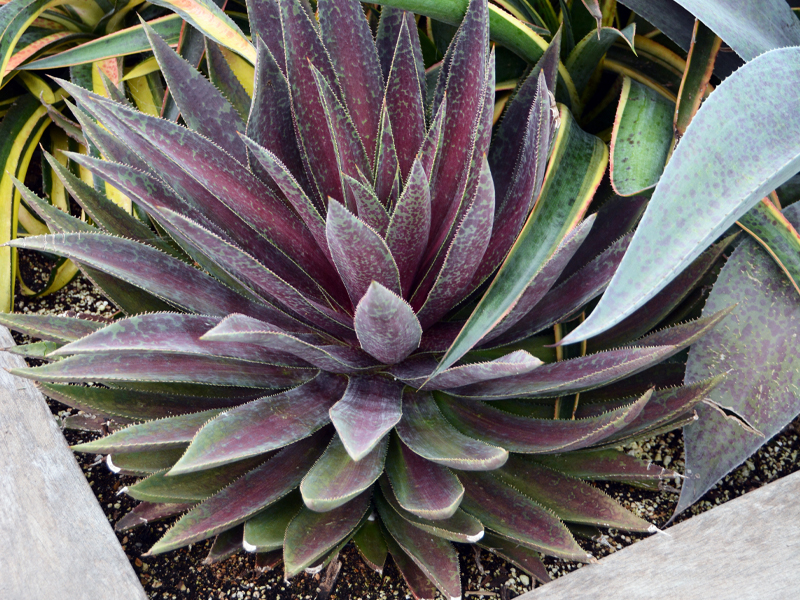
‘Blazing Saddles’ ★★★
Heavy red mottling covers nearly the entire leaf, concentrated mostly in the center. ‘Blazing Saddles’ forms a compact, star-like globe of pointed leaves edged with small serrations. Unknown flowering age (at least two years). 14 in. tall × 20 in. wide. Available in Walters Gardens 2023-2024 catalog.
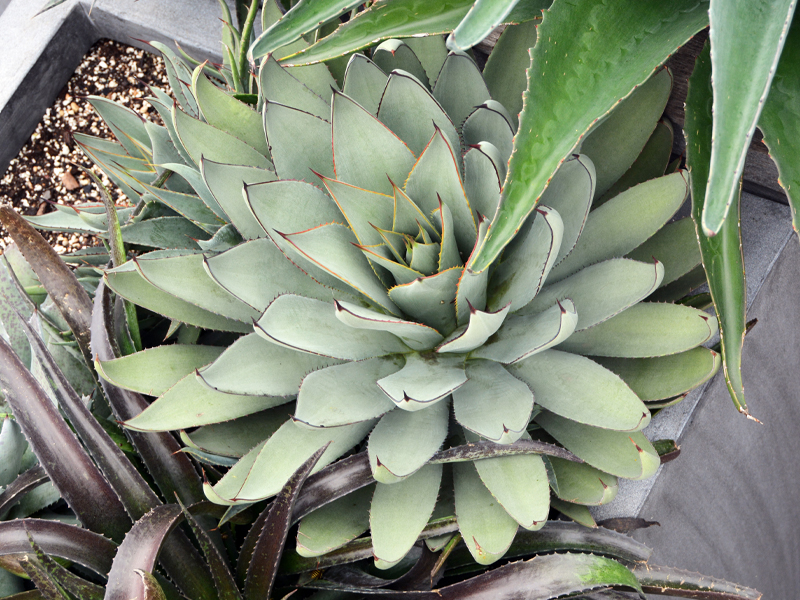
‘Blue Dart’ ★★★
Solid blue-gray leaves form a compact lotus shape while the marginal spines graphically outline each leaf in deep reddish-brown. Each terminal spine curves toward the center of the plant, contributing to a unique form and reducing the risk of accidental impalement. In the greenhouse, under less intense light conditions, the terminal spines pointed outward, which diminished the interesting habit of this plant. Unknown flowering age (at least four years). 14 in. tall × 20 in. wide. Not available in Walters Gardens 2023-2024 catalog.
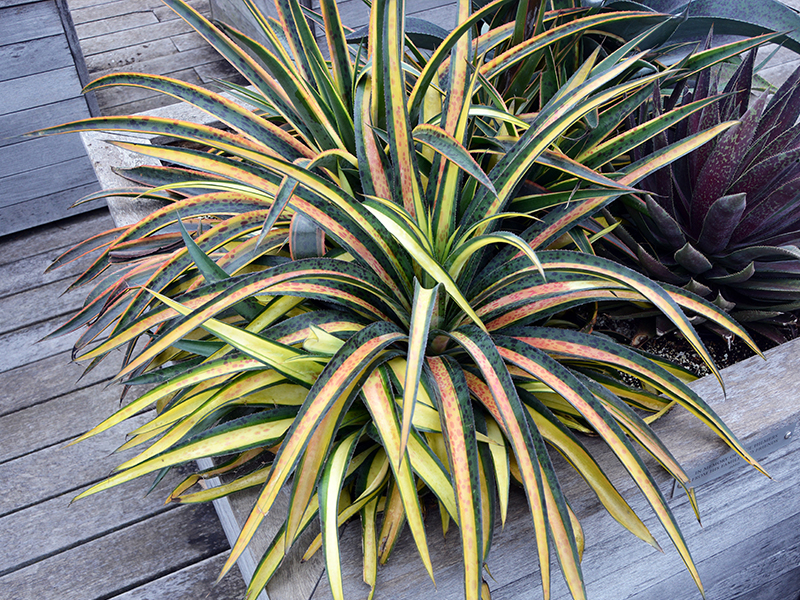
‘Carnival’ ★★★
Green leaves with chartreuse centers and overlaid with red spots create a riot of color. The long, strappy, arching foliage is reminiscent of a tropical bromeliad. The more exuberant growth and central variegation stood out from the similar ‘Kaleidoscope’ and ‘Snow Leopard’. Unknown flowering age (at least two years). 20 in. tall × 28 in. wide. Not available in Walters Gardens 2023-2024 catalog..
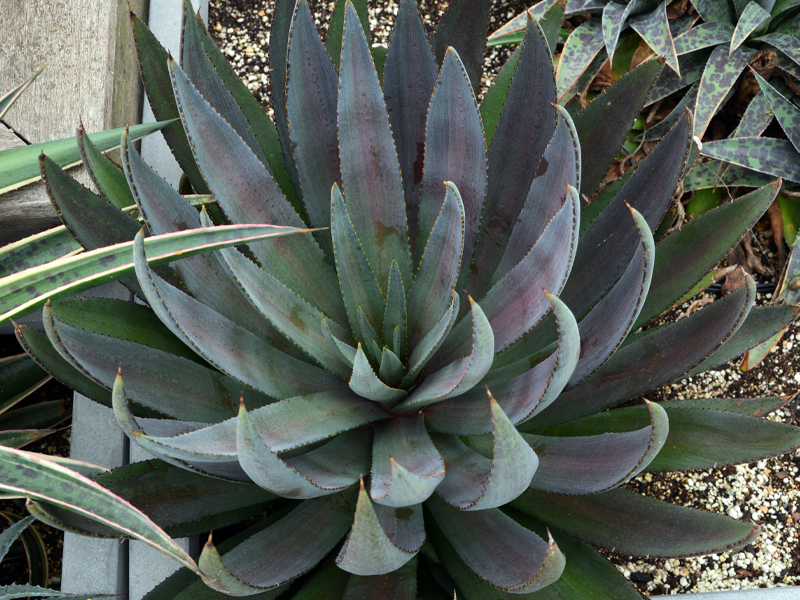
‘Desert Dawn’ ★★★
Narrow leaves curve inward, creating a unique basket-like form and protecting passersby from its spines. The upper sides of the leaves are deep eggplant with a lighter central stripe, best appreciated from above as the outward-facing undersides tend toward dark green. Flowered after three to four years. 14 in. tall × 18 in. wide. Not available in Walters Gardens 2023-2024 catalog.

‘Falling Waters’ ★★★
Broad blue-green leaves have toothy margins and faint spotting. Its undulating and cascading habit is reminiscent of a fountain as its foliage ebbs and flows around neighboring plants. Flowered after three to four years. 14 in. tall × 34 in. wide. Available in Walters Gardens 2023-2024 catalog.
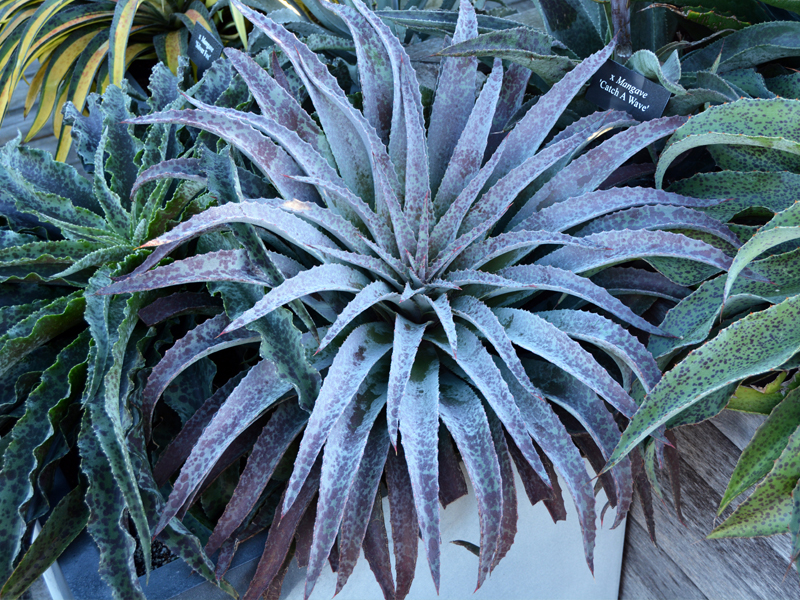
‘Femme Fatale’ ★★★
‘Femme Fatale’ combines delicate and dangerous with its slender, arching leaves and vicious spikes. Foliage is a frosty blue-green with mauve mottling concentrated at the tips. A downside to this variety is its incredibly brittle leaves that snap with just a light touch. Flowered after three to four years. 13 in. tall × 24 in. wide. Not available in Walters Gardens 2023-2024 catalog.

‘Frosted Elegance’ ★★★
Moderately spiny celadon leaves with light green centers form a star-shaped rosette. When under more stress during the first year of the trial, the appearance of ‘Frosted Elegance’ was enhanced by pink coloration on the foliar margins. Unknown flowering age (at least two years). 8 in. tall × 17 in. wide. Available in Walters Gardens 2023-2024 catalog.

‘Man of Steel’ ★★★
Steely blue daggers with sharp terminal spines emanate straight out from the center. The foliage is faintly spotted and takes on a lavenderbronze cast when stressed. Flowered after three to four years. 14 in. tall × 24 in. wide. Not available in Walters Gardens 2023-2024 catalog.
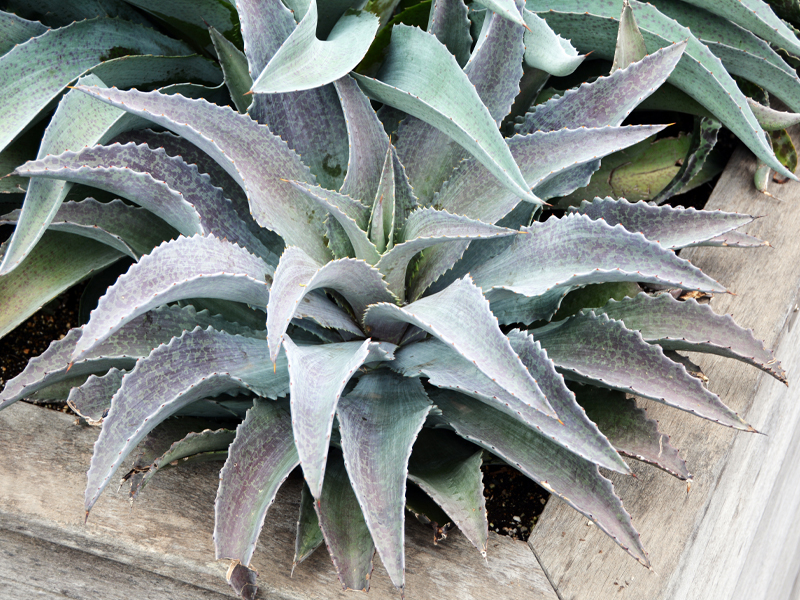
‘Mayan Queen’ ★★★
With nearly solid purple and toothy, gently undulating foliage, ‘Mayan Queen’ falls just short of the very similar ‘Purple People Eater’ for the latter’s added interest of its colorful spines. Unknown flowering age (at least four years). 15 in. tall × 26 in. wide. Not available in Walters Gardens 2023-2024 catalog.
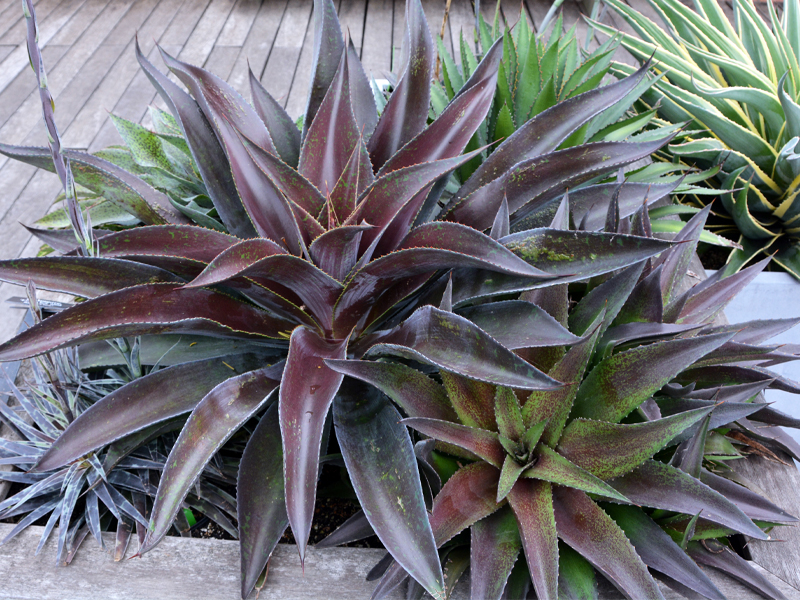
‘Mission to Mars’ ★★★
The largest in our trial, ‘Mission to Mars’ matches its bold size with intense, nearly solid red coloration. Upon closer inspection, green caruncles pepper the leaves, which may either be off-putting to some or add to its Martian appeal. Unknown flowering age (at least two years). 23 in. tall × 35 in. wide. Available in Walters Gardens 2023-2024 catalog.
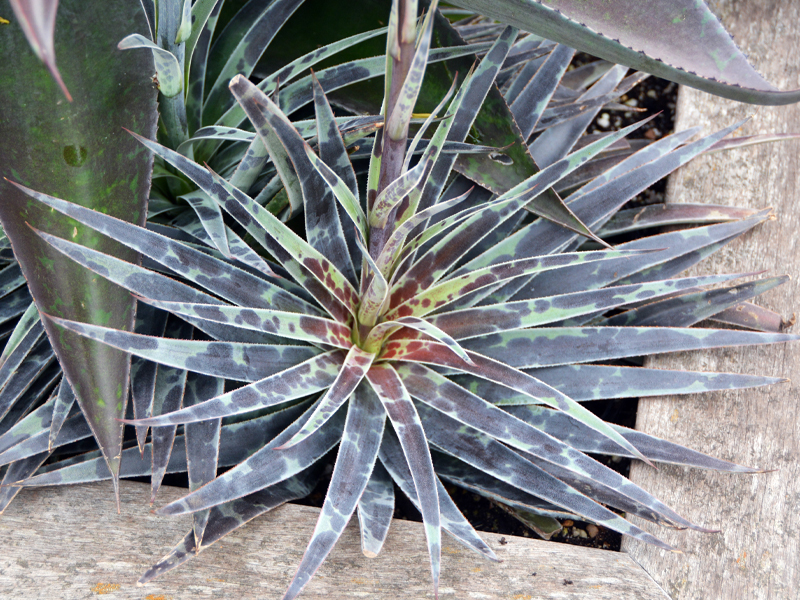
‘Moonglow’ ★★★
Silvery leaves blotched with burgundy and lined with fine white serrations evoke shadows cast on a moonlit night. This variety is quick to bloom but pups prolifically, forming a low-growing clump. Flowered after one to two years. 9 in. tall × 15 in. wide. Available in Walters Gardens 2023-2024 catalog.
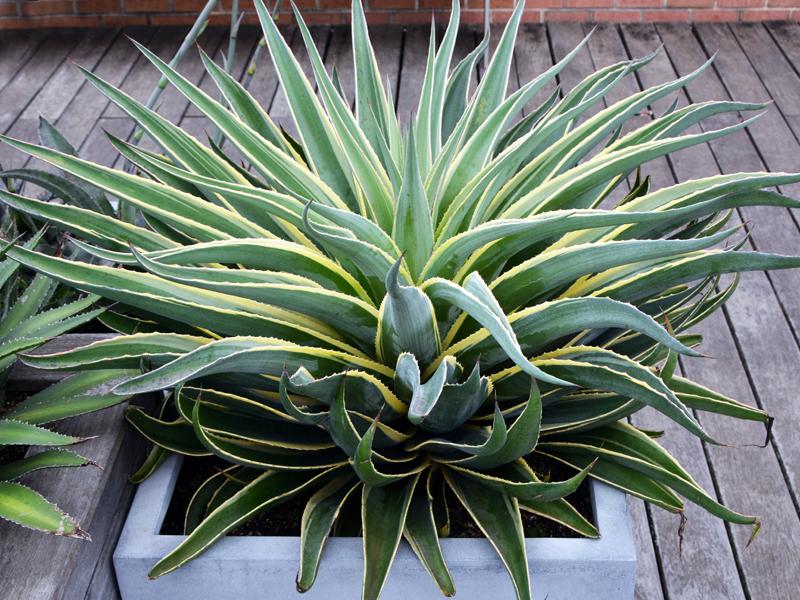
‘Navajo Princess’ ★★★
Narrow, spiny green leaves are edged with creamy yellow and modestly peppered with red spots. Unknown flowering age (at least two years). 20 in. tall × 32 in. wide. Not available in Walters Gardens 2023-2024 catalog.
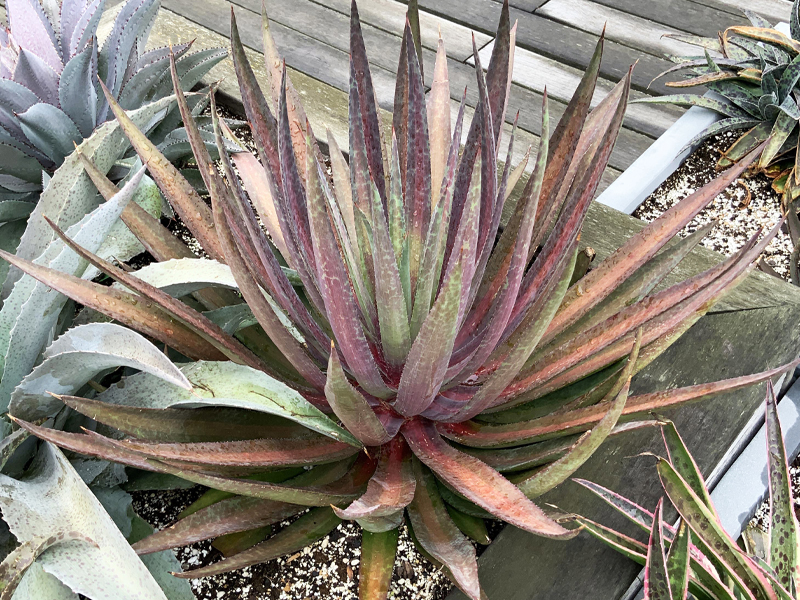
‘Painted Desert’ ★★★
‘Painted Desert’ earns its name from the rainbow of watercolor hues displayed as its leaves age. Each with a lighter central stripe, new leaves range from olive green to purple and red, aging to terra cotta orange. Flowered after two years. 16 in. tall × 25 in. wide. Not available in Walters Gardens 2023-2024 catalog.
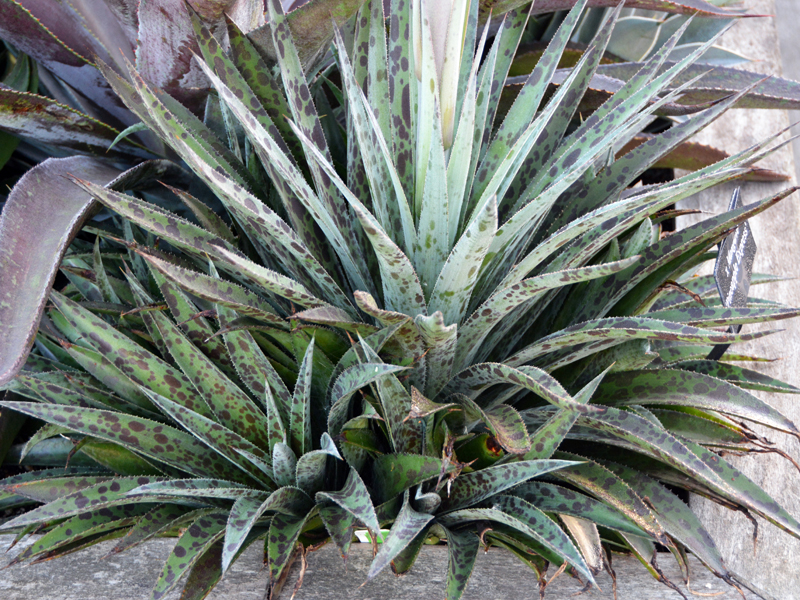
‘Pineapple Express’ ★★★
The mint green leaves of ‘Pineapple Express’ are generously splattered with purple spots. The rosettes indeed bear resemblance to the top of a pineapple and are similarly without any serious spines. Flowered after two years. 21 in. tall × 25 in. wide. Available in Walters Gardens 2023-2024 catalog.
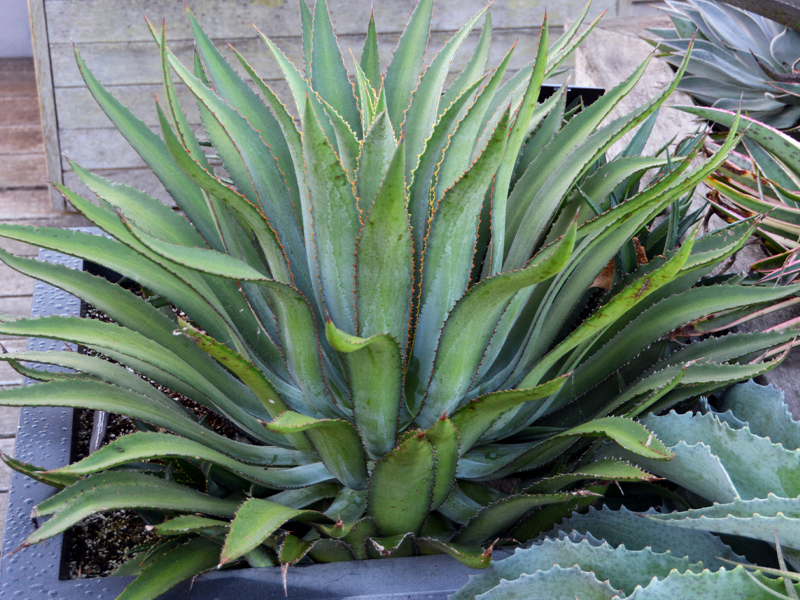
‘Racing Stripes’ ★★★
Narrow green foliage with a faint central band of chartreuse gently arches outward. Orange spines line the leaf margins in a distinct scalloped pattern. Unknown flowering age (at least two years). 18 in. tall × 25 in. wide. Available in Walters Gardens 2023-2024 catalog.
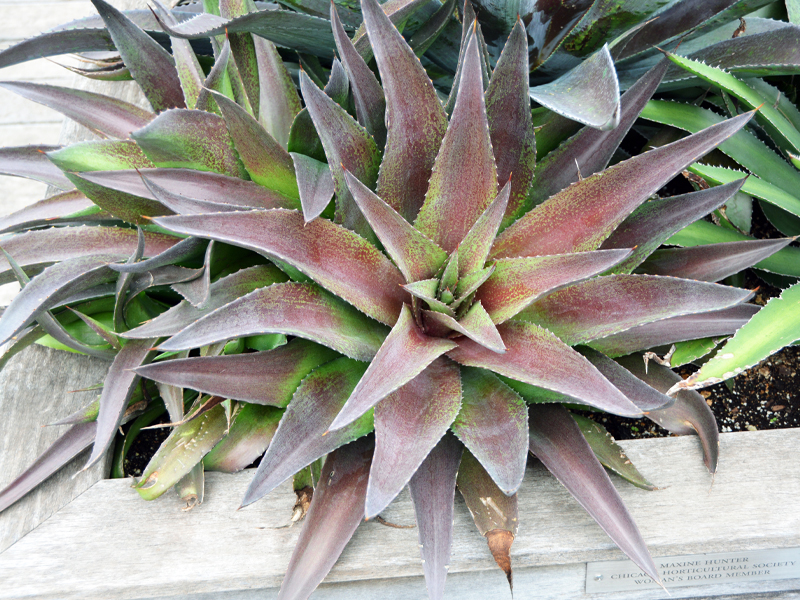
‘Red Wing’ ★★★
Very similar to ‘Mission to Mars’, ‘Red Wing’ grew slightly smaller and had less intense red coloration; shaded portion of the leaves were green. Unknown flowering age (at least two years). 13 in. tall × 22 in. wide. Available in Walters Gardens 2023-2024 catalog.
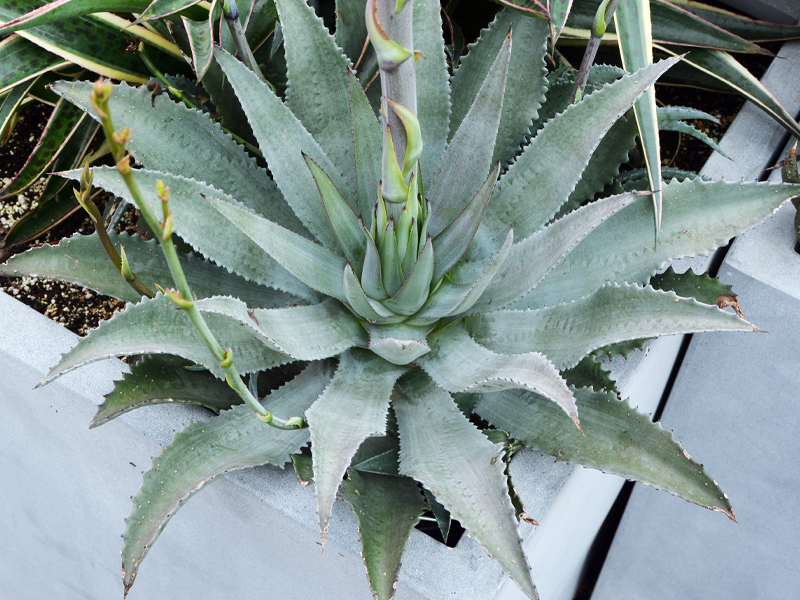
‘Silver Fox’ ★★★
‘Silver Fox’ stands out for its coloration: a strong metallic sheen with lavender undertones. Spiny foliage arches up and out. Flowered after two years. 13 in. tall × 20 in. wide. Available in Walters Gardens 2023- 2024 catalog.

‘Whale Tale’ ★★★
The broad, spiny foliage of ‘Whale Tale’ is silvery blue and faintly speckled. The tendency for portions of the leaves to lose their glaucous coating detracts from its aesthetic value. Flowered after three to four years. 15 in. tall × 35 in. wide. Not available in Walters Gardens 2023-2024 catalog.

‘Bad Hair Day’ ★★★
A dense mop of grassy, pliable foliage invites the touch of a passerby. Leaves are green with subtle spotting, taking on a bronze cast when stressed, and lacking sharp spines. Flowered after three to four years. 16 in. tall × 36 in. wide. Not available in Walters Gardens 2023-2024 catalog.

‘Blazing Saddles’ ★★★
Heavy red mottling covers nearly the entire leaf, concentrated mostly in the center. ‘Blazing Saddles’ forms a compact, star-like globe of pointed leaves edged with small serrations. Unknown flowering age (at least two years). 14 in. tall × 20 in. wide. Available in Walters Gardens 2023-2024 catalog.

‘Blue Dart’ ★★★
Solid blue-gray leaves form a compact lotus shape while the marginal spines graphically outline each leaf in deep reddish-brown. Each terminal spine curves toward the center of the plant, contributing to a unique form and reducing the risk of accidental impalement. In the greenhouse, under less intense light conditions, the terminal spines pointed outward, which diminished the interesting habit of this plant. Unknown flowering age (at least four years). 14 in. tall × 20 in. wide. Not available in Walters Gardens 2023-2024 catalog.

‘Carnival’ ★★★
Green leaves with chartreuse centers and overlaid with red spots create a riot of color. The long, strappy, arching foliage is reminiscent of a tropical bromeliad. The more exuberant growth and central variegation stood out from the similar ‘Kaleidoscope’ and ‘Snow Leopard’. Unknown flowering age (at least two years). 20 in. tall × 28 in. wide. Not available in Walters Gardens 2023-2024 catalog..

‘Desert Dawn’ ★★★
Narrow leaves curve inward, creating a unique basket-like form and protecting passersby from its spines. The upper sides of the leaves are deep eggplant with a lighter central stripe, best appreciated from above as the outward-facing undersides tend toward dark green. Flowered after three to four years. 14 in. tall × 18 in. wide. Not available in Walters Gardens 2023-2024 catalog.

‘Falling Waters’ ★★★
Broad blue-green leaves have toothy margins and faint spotting. Its undulating and cascading habit is reminiscent of a fountain as its foliage ebbs and flows around neighboring plants. Flowered after three to four years. 14 in. tall × 34 in. wide. Available in Walters Gardens 2023-2024 catalog.

‘Femme Fatale’ ★★★
‘Femme Fatale’ combines delicate and dangerous with its slender, arching leaves and vicious spikes. Foliage is a frosty blue-green with mauve mottling concentrated at the tips. A downside to this variety is its incredibly brittle leaves that snap with just a light touch. Flowered after three to four years. 13 in. tall × 24 in. wide. Not available in Walters Gardens 2023-2024 catalog.

‘Frosted Elegance’ ★★★
Moderately spiny celadon leaves with light green centers form a star-shaped rosette. When under more stress during the first year of the trial, the appearance of ‘Frosted Elegance’ was enhanced by pink coloration on the foliar margins. Unknown flowering age (at least two years). 8 in. tall × 17 in. wide. Available in Walters Gardens 2023-2024 catalog.

‘Man of Steel’ ★★★
Steely blue daggers with sharp terminal spines emanate straight out from the center. The foliage is faintly spotted and takes on a lavenderbronze cast when stressed. Flowered after three to four years. 14 in. tall × 24 in. wide. Not available in Walters Gardens 2023-2024 catalog.

‘Mayan Queen’ ★★★
With nearly solid purple and toothy, gently undulating foliage, ‘Mayan Queen’ falls just short of the very similar ‘Purple People Eater’ for the latter’s added interest of its colorful spines. Unknown flowering age (at least four years). 15 in. tall × 26 in. wide. Not available in Walters Gardens 2023-2024 catalog.

‘Mission to Mars’ ★★★
The largest in our trial, ‘Mission to Mars’ matches its bold size with intense, nearly solid red coloration. Upon closer inspection, green caruncles pepper the leaves, which may either be off-putting to some or add to its Martian appeal. Unknown flowering age (at least two years). 23 in. tall × 35 in. wide. Available in Walters Gardens 2023-2024 catalog.

‘Moonglow’ ★★★
Silvery leaves blotched with burgundy and lined with fine white serrations evoke shadows cast on a moonlit night. This variety is quick to bloom but pups prolifically, forming a low-growing clump. Flowered after one to two years. 9 in. tall × 15 in. wide. Available in Walters Gardens 2023-2024 catalog.

‘Navajo Princess’ ★★★
Narrow, spiny green leaves are edged with creamy yellow and modestly peppered with red spots. Unknown flowering age (at least two years). 20 in. tall × 32 in. wide. Not available in Walters Gardens 2023-2024 catalog.

‘Painted Desert’ ★★★
‘Painted Desert’ earns its name from the rainbow of watercolor hues displayed as its leaves age. Each with a lighter central stripe, new leaves range from olive green to purple and red, aging to terra cotta orange. Flowered after two years. 16 in. tall × 25 in. wide. Not available in Walters Gardens 2023-2024 catalog.

‘Pineapple Express’ ★★★
The mint green leaves of ‘Pineapple Express’ are generously splattered with purple spots. The rosettes indeed bear resemblance to the top of a pineapple and are similarly without any serious spines. Flowered after two years. 21 in. tall × 25 in. wide. Available in Walters Gardens 2023-2024 catalog.

‘Racing Stripes’ ★★★
Narrow green foliage with a faint central band of chartreuse gently arches outward. Orange spines line the leaf margins in a distinct scalloped pattern. Unknown flowering age (at least two years). 18 in. tall × 25 in. wide. Available in Walters Gardens 2023-2024 catalog.

‘Red Wing’ ★★★
Very similar to ‘Mission to Mars’, ‘Red Wing’ grew slightly smaller and had less intense red coloration; shaded portion of the leaves were green. Unknown flowering age (at least two years). 13 in. tall × 22 in. wide. Available in Walters Gardens 2023-2024 catalog.

‘Silver Fox’ ★★★
‘Silver Fox’ stands out for its coloration: a strong metallic sheen with lavender undertones. Spiny foliage arches up and out. Flowered after two years. 13 in. tall × 20 in. wide. Available in Walters Gardens 2023- 2024 catalog.

‘Whale Tale’ ★★★
The broad, spiny foliage of ‘Whale Tale’ is silvery blue and faintly speckled. The tendency for portions of the leaves to lose their glaucous coating detracts from its aesthetic value. Flowered after three to four years. 15 in. tall × 35 in. wide. Not available in Walters Gardens 2023-2024 catalog.
-
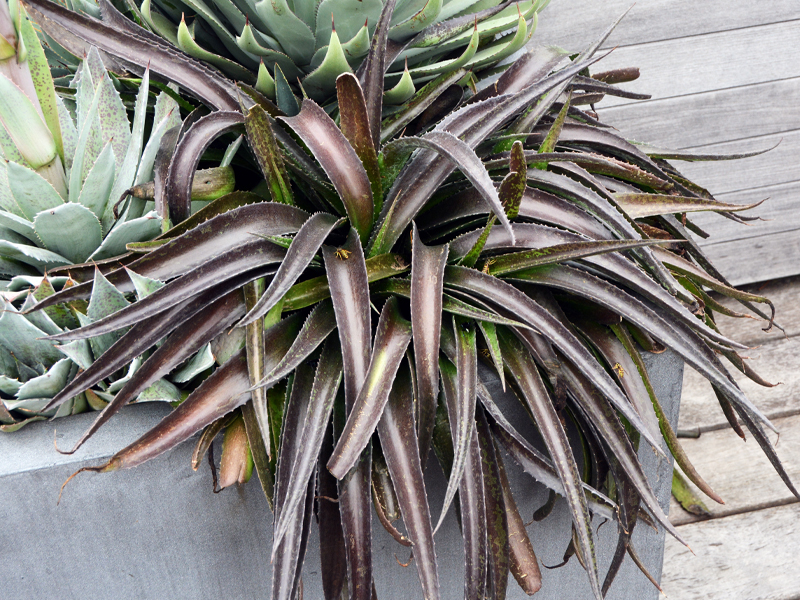
‘Coffee Jitters’ ★★
The darkest in our trial, the foliage of ‘Coffee Jitters’ is a nearly solid chocolatey bronze. It has a chaotic form as its flaccid leaves dangle over the side of the container and snake their way among other plants. Unknown flowering age (at least two years). 13 in. tall × 29 in. wide. Not available in Walters Gardens 2023-2024 catalog.
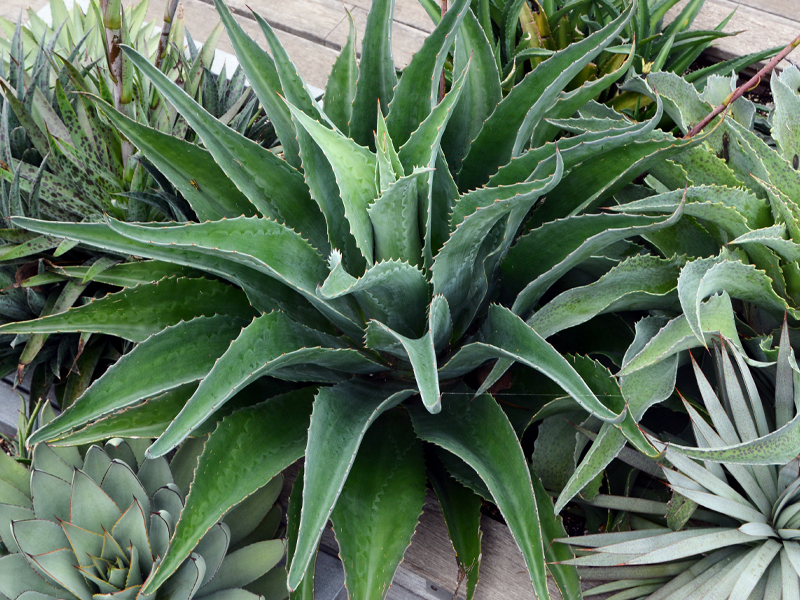
‘Iron Man’ ★★
The broad leaves of ‘Iron Man’ fold and arch outward with a deep green color and faint silver sheen. The lower placement of this variety is due to its failure to incorporate the unique characteristics of Manfreda, looking simply like a green agave. Unknown flowering age (at least two years). 20 in. tall × 36 in. wide. Not available in Walters Gardens 2023-2024 catalog.
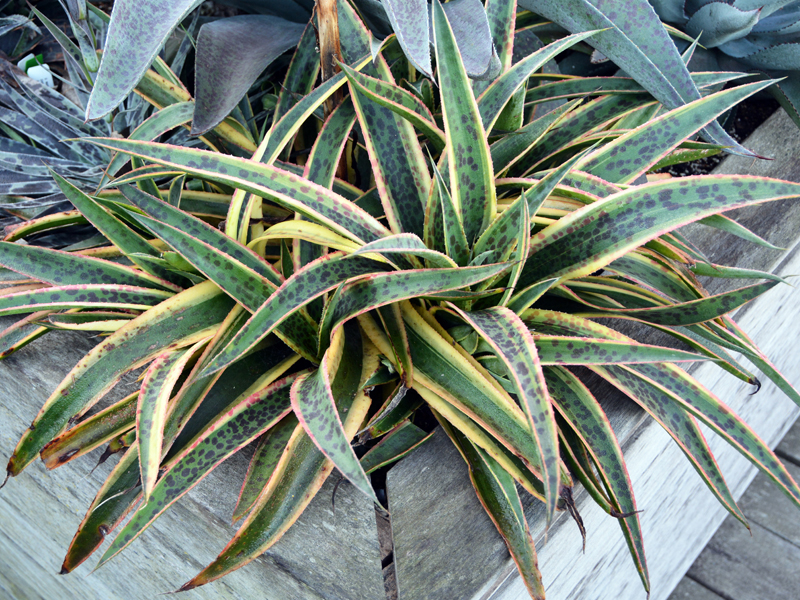
‘Kaleidoscope’ ★★
Strappy foliage is green with creamy yellow margins, turning more reddish when stressed, and speckled with burgundy. Flowered after two years. 17 in. tall × 27 in. wide. Not available in Walters Gardens 2023-2024 catalog.

‘Shadow Waltz’ ★★
Narrow, moderately spiny leaves are green with subtle light green central stripes. Flowered after three to four years. 11 in. tall × 16 in. wide. Not available in Walters Gardens 2023-2024 catalog.
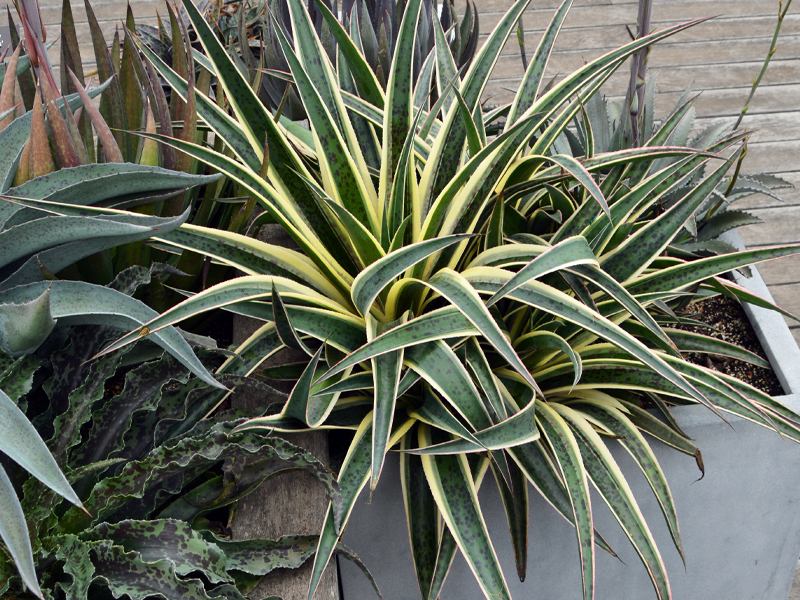
‘Snow Leopard’ ★★
Long, strappy leaves are dark green with creamy margins and speckled with red. Excessive pupping obscured the growth form of this variety, contributing to its lower rating. Flowered after one to three years. 17 in. tall × 21 in. wide. Available in Walters Gardens 2023-2024 catalog.

‘Thunderbird’ ★★
Blue-green leaves heavily spotted with burgundy form a compact rosette. After flowering, the habit completely changed as the multitude of pups formed a dense, hedgehog-like mound. Flowered after two years. 10 in. tall × 13 in. wide. Not available in Walters Gardens 2023-2024 catalog.

‘Coffee Jitters’ ★★
The darkest in our trial, the foliage of ‘Coffee Jitters’ is a nearly solid chocolatey bronze. It has a chaotic form as its flaccid leaves dangle over the side of the container and snake their way among other plants. Unknown flowering age (at least two years). 13 in. tall × 29 in. wide. Not available in Walters Gardens 2023-2024 catalog.

‘Iron Man’ ★★
The broad leaves of ‘Iron Man’ fold and arch outward with a deep green color and faint silver sheen. The lower placement of this variety is due to its failure to incorporate the unique characteristics of Manfreda, looking simply like a green agave. Unknown flowering age (at least two years). 20 in. tall × 36 in. wide. Not available in Walters Gardens 2023-2024 catalog.

‘Kaleidoscope’ ★★
Strappy foliage is green with creamy yellow margins, turning more reddish when stressed, and speckled with burgundy. Flowered after two years. 17 in. tall × 27 in. wide. Not available in Walters Gardens 2023-2024 catalog.

‘Shadow Waltz’ ★★
Narrow, moderately spiny leaves are green with subtle light green central stripes. Flowered after three to four years. 11 in. tall × 16 in. wide. Not available in Walters Gardens 2023-2024 catalog.

‘Snow Leopard’ ★★
Long, strappy leaves are dark green with creamy margins and speckled with red. Excessive pupping obscured the growth form of this variety, contributing to its lower rating. Flowered after one to three years. 17 in. tall × 21 in. wide. Available in Walters Gardens 2023-2024 catalog.

‘Thunderbird’ ★★
Blue-green leaves heavily spotted with burgundy form a compact rosette. After flowering, the habit completely changed as the multitude of pups formed a dense, hedgehog-like mound. Flowered after two years. 10 in. tall × 13 in. wide. Not available in Walters Gardens 2023-2024 catalog.
-
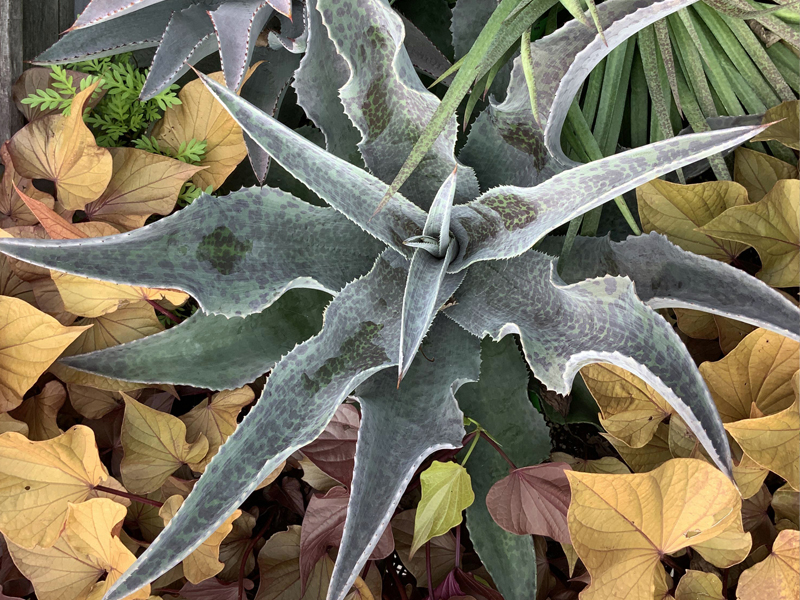
‘Catch a Wave’ ★
Folded, undulating leaves are silvery hued with dark speckling. The poor rating is due to the speed at which our plants flowered: one bloomed before the trial even began, leaving little time to appreciate the plant. Basal pups bloomed simultaneously, which would deny gardeners the opportunity to propagate the plant after its short lifespan. Flowered after one to two years. 12 in. tall × 25 in. wide. Not available in Walters Gardens 2023-2024 catalog.
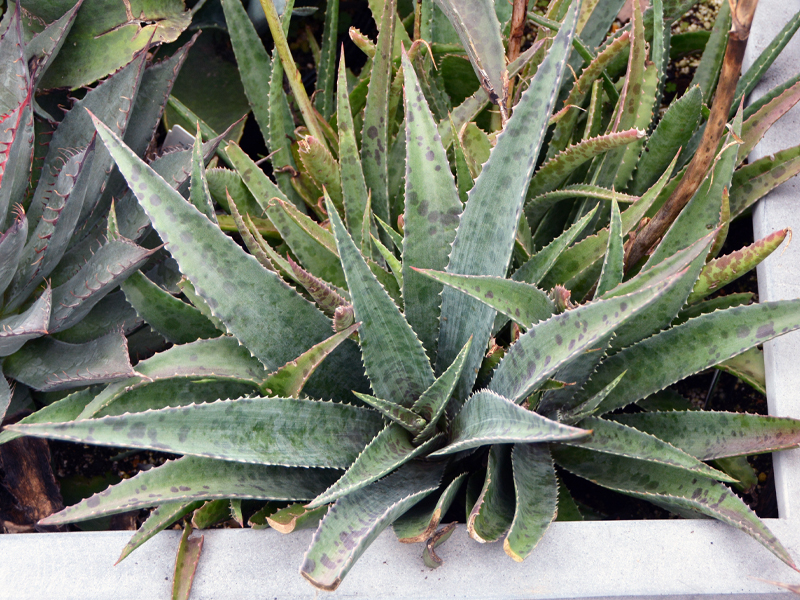
‘Freckles and Speckles’ ★
Narrow, moderately spiny leaves are blue-green—bronze when stressed— with burgundy spots. After blooming, the pups of ‘Freckles and Speckles’ formed a messy clump with discolored old foliage and the intensity of their freckles faded. Flowered after one year. 9 in. tall × 16 in. wide. Not available in Walters Gardens 2023-2024 catalog.
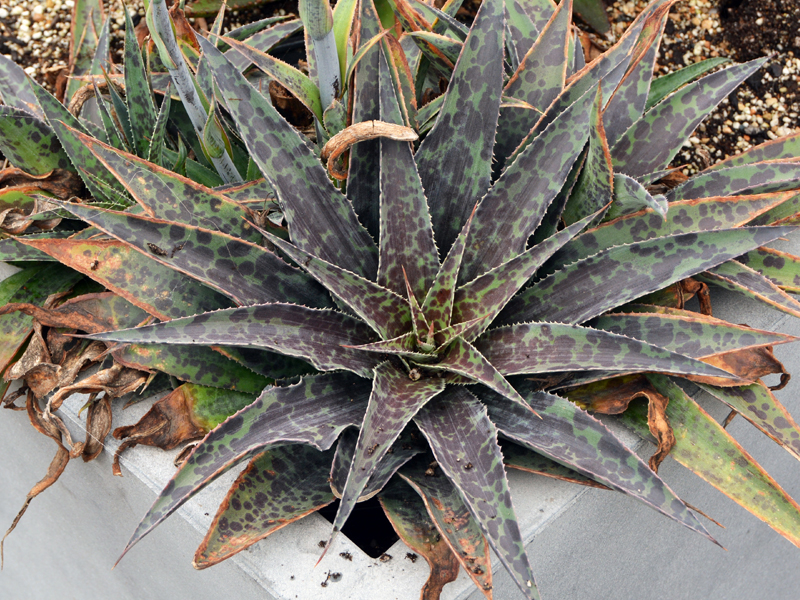
‘Inkblot’ ★
Narrow, pliable leaves are blue-green with dense burgundy spotting and small marginal serrations. After blooming, the resulting clump of pups had marred, browned leaf tips. Bloomed after one to two years. 7 in. tall × 14 in. wide. Available in Walters Gardens 2023-2024 catalog.
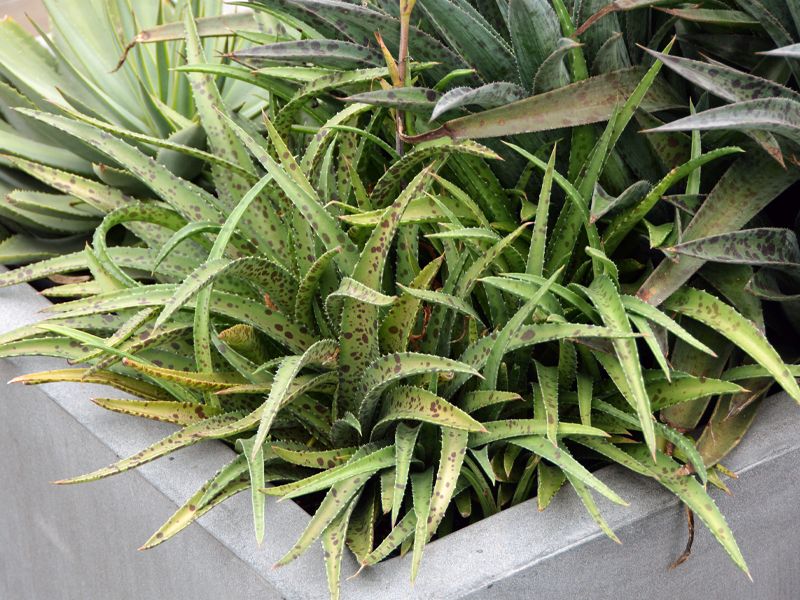
‘My Dog Spot’ ★
‘My Dog Spot’ gets lost among the mix with neither interesting coloration nor architecture. Narrow green leaves spotted with burgundy possess small marginal spines. The form of the original plant was lost after blooming and the older foliage took on a sickly yellow cast. Bloomed after one year. 10 in. tall × 20 in. wide. Not available in Walters Gardens 2023-2024 catalog.

‘Catch a Wave’ ★
Folded, undulating leaves are silvery hued with dark speckling. The poor rating is due to the speed at which our plants flowered: one bloomed before the trial even began, leaving little time to appreciate the plant. Basal pups bloomed simultaneously, which would deny gardeners the opportunity to propagate the plant after its short lifespan. Flowered after one to two years. 12 in. tall × 25 in. wide. Not available in Walters Gardens 2023-2024 catalog.

‘Freckles and Speckles’ ★
Narrow, moderately spiny leaves are blue-green—bronze when stressed— with burgundy spots. After blooming, the pups of ‘Freckles and Speckles’ formed a messy clump with discolored old foliage and the intensity of their freckles faded. Flowered after one year. 9 in. tall × 16 in. wide. Not available in Walters Gardens 2023-2024 catalog.

‘Inkblot’ ★
Narrow, pliable leaves are blue-green with dense burgundy spotting and small marginal serrations. After blooming, the resulting clump of pups had marred, browned leaf tips. Bloomed after one to two years. 7 in. tall × 14 in. wide. Available in Walters Gardens 2023-2024 catalog.

‘My Dog Spot’ ★
‘My Dog Spot’ gets lost among the mix with neither interesting coloration nor architecture. Narrow green leaves spotted with burgundy possess small marginal spines. The form of the original plant was lost after blooming and the older foliage took on a sickly yellow cast. Bloomed after one year. 10 in. tall × 20 in. wide. Not available in Walters Gardens 2023-2024 catalog.
-
With their variability in color, pattern, and form, selecting a mangave mainly comes down to the gardener’s personal taste. However, this trial illuminated features not evident when strolling through the garden center. The plant’s evolution over time—how long it takes to bloom, changes after flowering, and response to environmental shifts—should be considered when choosing a mangave.
Being so new to the gardening world, the selection of mangave cultivars is evolving rapidly. Their instant market success, owing to their variety, versatility, and ease of maintenance, ensures the continued breeding of these plants. Since this trial was conducted, Walters Gardens has introduced new cultivars and discontinued others from its catalog. While some favorites may be harder to find, gardeners should be on the lookout for new and exciting mangaves in the coming years.
With their variability in color, pattern, and form, selecting a mangave mainly comes down to the gardener’s personal taste. However, this trial illuminated features not evident when strolling through the garden center. The plant’s evolution over time—how long it takes to bloom, changes after flowering, and response to environmental shifts—should be considered when choosing a mangave.
Being so new to the gardening world, the selection of mangave cultivars is evolving rapidly. Their instant market success, owing to their variety, versatility, and ease of maintenance, ensures the continued breeding of these plants. Since this trial was conducted, Walters Gardens has introduced new cultivars and discontinued others from its catalog. While some favorites may be harder to find, gardeners should be on the lookout for new and exciting mangaves in the coming years.

